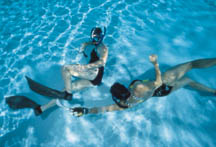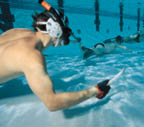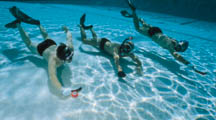
Freedive!
CHAPTER
EXCERPTS
|
 |
FREEDIVE!
by Terry Maas and David SipperlyUnderwater
Hockey

If you love the water, enjoy team play and are looking for a way
to stay in excellent shape, then underwater hockey is your sport.
Originally played by freedivers to stay in shape during the winter months, underwater
hockey has developed into a highly organized and competitive sport over the last 15 years.
This lively sport enjoys national and international recognition. To help us explain the
basics, we've interviewed Kendall Banks and Tim Burke, two nationally recognized
competitors with world championship experience. Tim was the 1996 Underwater Society of
America's Underwater Hockey Athlete of the year. Kendall has served as National Underwater
Hockey Director for the Underwater Society of America and has represented the United
States eight times on the national team in world play; his teammates have elected him
captain seven times.
Underwater hockey is loads of fun, but be forewarned: this is one tough sport. It's like
running up and down a flight of stairs on a single breath, breathing again at the bottom
of the stairs and then repeating this cycle for fifteen minutes. It is a high intensity,
anaerobic sport that requires excellent physical fitness. "Although long breath-holds
are helpful, they are not critical to success," Tim stresses. "It is more
important to couple short, effective breath-hold times-enough to complete each play-with
short surface intervals."
In underwater hockey, two teams of six, wearing only masks, fins and snorkels, compete in
a swimming pool. Their objective is to drive the puck with short hockey sticks into their
opponent's goal. "It is similar to ice hockey, where speed, puck control, passing and
awareness of others is critical," says Tim. "Yet it is played on the bottom of a
swimming pool while you hold your breath.".............

The rules are simple: no standing on the pool bottom or blatant
fouling (holding or grabbing another). Although incidental contact does occur, underwater
hockey is still considered a non-contact sport. Are there any risks? Sure—blackout
from over-exertion, broken noses and teeth from puck-passing and ruptured eardrums from
fin slaps are possible, but rare; and, in most cases, preventable with the use of proper
gear. The most common injuries are bruises and cuts on the knees and knuckles caused by
striking the pool bottom or being hit by sticks and pucks.
The gear required to play underwater hockey is minimal. “All you need are mask, fins,
snorkel, a glove, hockey stick, head and ear protection, a mouth guard and a good roll of
duct-tape,” says Kendall. You can purchase most of the special gear from the
Underwater Society of America (USofA).” Use duct-tape for field repairs or for
securing fins to your feet............

Finally, don’t forget your mouth guard. It is made from the
chin strap of a roller blade helmet cut to fit around the mouthpiece of your snorkel.
Duct-tape is often used to secure it in place. The mouth guard is the newest piece of
safety equipment mandated by the USofA because there have been several occasions where
divers required extensive dental treatment after receiving a blow to the mouth from a
puck.
Tim is quick to offer some advice to beginners. “Keep your stick out in front of you
at all times, limit your breath-hold times to short, effective durations and
otherwise follow the play on the surface,” he says. “Work on puck-handling,
shooting and curling. Coordinate the timing of your surface dive to anticipate the play
and your teammates. Improve your physical conditioning by swimming with and without
fins.”
You can locate the closest underwater hockey team in your area by contacting the USofA or
your local dive shop. Because teams are always looking for new players, they often recruit
by conducting training seminars and demonstrations. We’re confident that you will
find this sport exciting, and an excellent way to stay in shape during the “off
season.”
|


